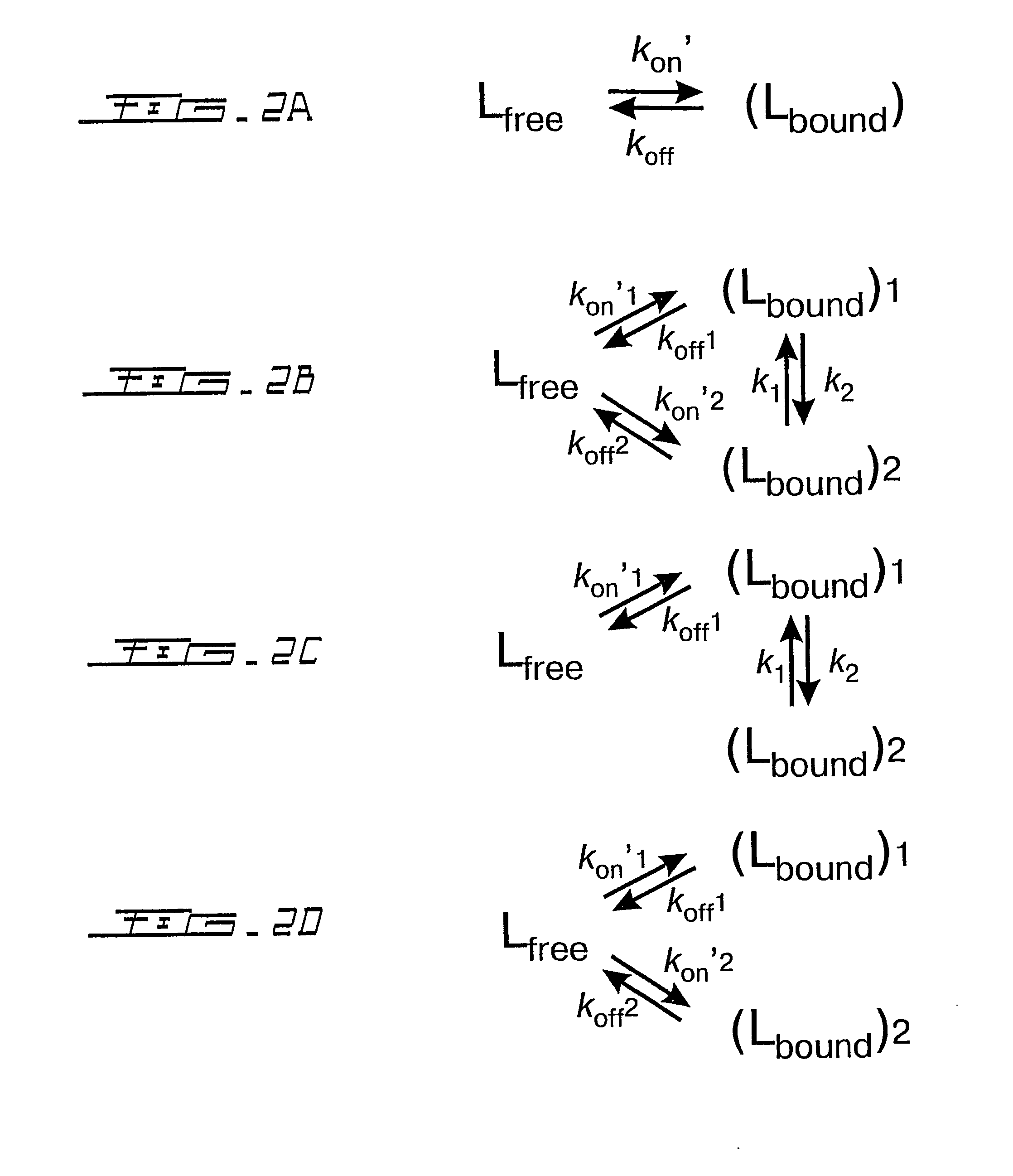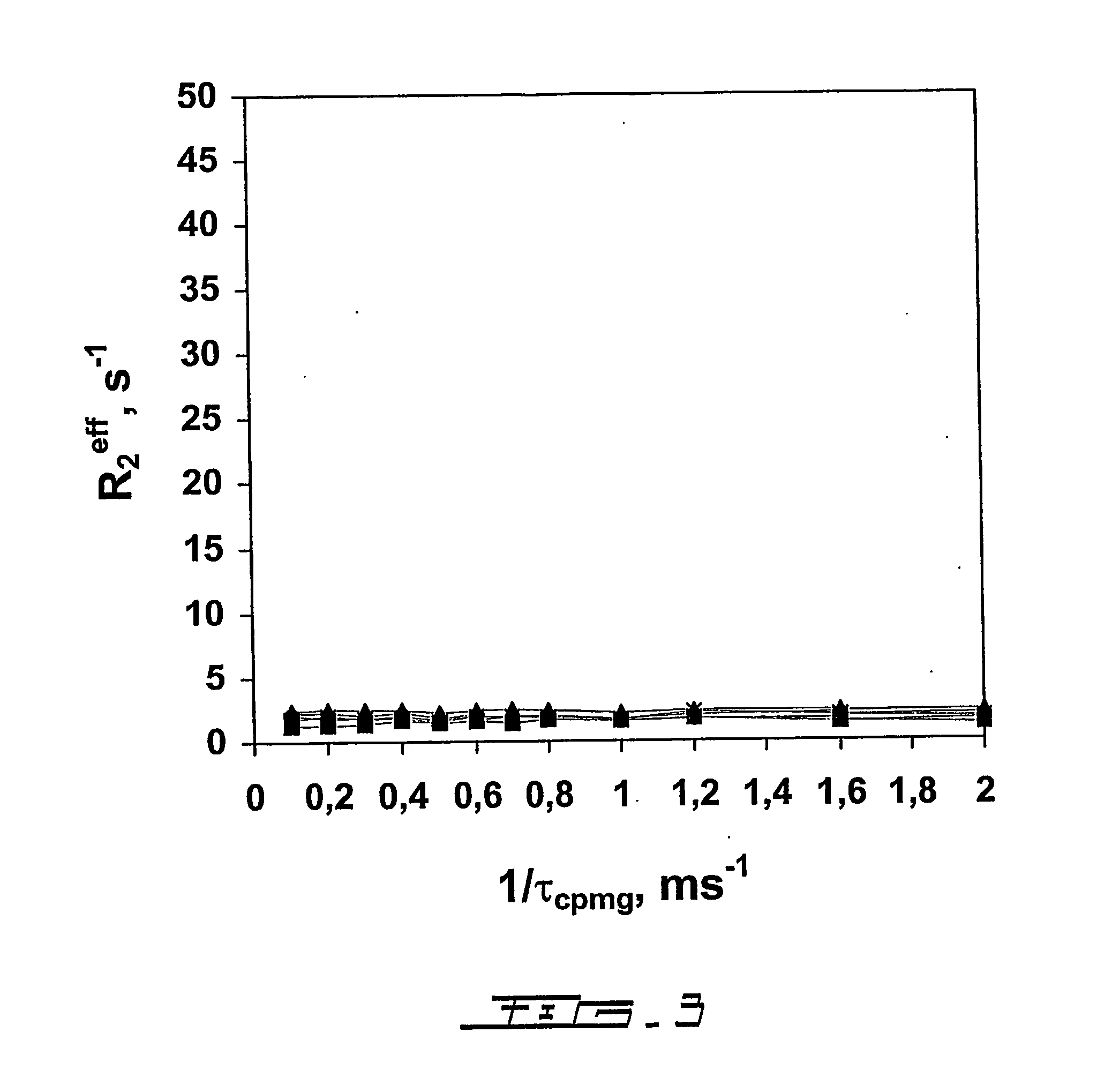Quantitative ranking of transient ligand binding to target biomolecules
a ligand binding and biomolecule technology, applied in the field of nmr, can solve the problems of not being normally or easily accessible to direct nmr observation, not providing a macroscopic description of the binding kinetics, and still difficult if not impossible to explain quantitatively the exact correlation between molecular structures
- Summary
- Abstract
- Description
- Claims
- Application Information
AI Technical Summary
Benefits of technology
Problems solved by technology
Method used
Image
Examples
example 1
Quantitative Determination of the Dissociation Rate Constant koff of Transient Protein-Ligand Complexes Without Precise Knowledge of the Ligand and Protein Concentrations: Binding of the N-acetyl-Hir(55-65) Peptide to Human Prothrombin
[0095] The changes in 15N transverse relaxation dispersion of a selectively 15N-labeled N-acetyl-*Asp55-*Phe-*Glu-*Glu-*Ile-Pro60-Glu-Glu-Tyr-Leu-Gln65-COOH (SEQ ID NO:15)(N-acetyl-Hir(55-65)) were followed as a function of the concentration of the binding protein, human prothrombin. The 15N NMR transverse relaxation rate of the 11-residue peptide is not responsive to the CPMG pulse rate (FIG. 3). Interaction of the peptide with the fibrinogen recognition site of prothrombin (Ni, F., Ning, Q., Jackson, C. M., and Fenton, J. W. (1993) J.Biol.Chem. 268, 16899-16902; and Anderson, P. J., Nesset, A., Dharmawardana, K. R., and Bock, P. E. (2000) J.Biol.Chem. 275, 16428-16434) causes broadening of the peptide's amide proton resonances (Ni, F., Ning, Q., Jac...
example 2
Quantitative Determination of the Dissociation Rate Constant koff of Transient Protein-Ligand Complexes Without Precise Knowledge of the Ligand and Protein Concentrations: a Uniformly s5N-Labeled Recombinant Peptide Interacting With Human Prothrombin
[0102] A peptide Gly54-Asp55-Phe56Glu57-Glu58-Ile59-Pro60-Glu61-Glu62-Tyr63-Leu64-Gln65 (SEQ ID NO:19)(Hir(54-65)), related to the N-acetyl-Hir(55-65) peptide, was recombinantly expressed and uniformly labeled with the 15N isotope. The Hir(54-65) peptide was dissolved at ˜1.5 mM in an aqueous solution that was 50 mM in sodium phosphate at pH 5.5. NMR peak assignments were carried out as described hereinabove. The free peptide produces relaxation dispersion curves independent of the CPMG pulse rate (FIG. 7). Upon the addition of prothrombin, the peptide gives 15N relaxation dispersion curves and koff rates very similar to those obtained for its synthetic analog N-acetyl-Hir(55-65) (FIGS. 4 and 8, Table 3).
[0103] In FIG. 7, the curves fo...
example 3
Quantitative Determination of the Dissociation Rate Constant koff of Transient Protein-Ligand Complexes Without Precise Knowledge of the Ligand and Protein Concentrations: the Synthetic N-acetyl-Hir(55-65) Peptide in Complex With Human Thrombin
[0105] The peptide N-acetyl-Hir(55-65) also binds to human thrombin with a higher affinity than for the same site on human prothrombin (Ni, F., Ning, Q., Jackson, C. M., and Fenton, J. W. (1993) J.Biol.Chem. 268, 16899-16902).
[0106]FIGS. 9A to 9D show the 15N relaxation dispersion profiles for the residues of the peptide N-acetyl-Hir(55-65) in the presence of human thrombin at a protein:peptide ratio of ˜1:15. The dispersion curves show expected quantitative differences compared to those for the N-acetyl-Hir(55-65)-prothrombin complex. There were little differences in the lineshapes of the one-dimensional proton NMR spectra of the thrombin-peptide complex obtained at the two magnetic fields, namely at 500 and 800 MHz. On the other hand, the ...
PUM
| Property | Measurement | Unit |
|---|---|---|
| Temperature | aaaaa | aaaaa |
| Temperature | aaaaa | aaaaa |
| Temperature | aaaaa | aaaaa |
Abstract
Description
Claims
Application Information
 Login to View More
Login to View More - R&D
- Intellectual Property
- Life Sciences
- Materials
- Tech Scout
- Unparalleled Data Quality
- Higher Quality Content
- 60% Fewer Hallucinations
Browse by: Latest US Patents, China's latest patents, Technical Efficacy Thesaurus, Application Domain, Technology Topic, Popular Technical Reports.
© 2025 PatSnap. All rights reserved.Legal|Privacy policy|Modern Slavery Act Transparency Statement|Sitemap|About US| Contact US: help@patsnap.com



